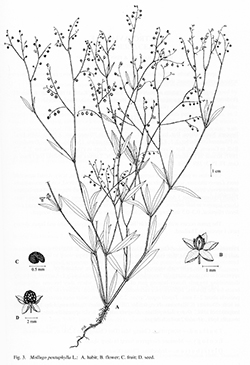e-Flora of Thailand
Volume 9 > Part 1 > Year 2005 > Page 47 > Molluginaceae > Mollugo
2. Mollugo pentaphylla L.wfo-0001294503
Sp. Pl. 1: 89. 1753; Seringe in DC., Prodr. 1: 392. 1824; C.B.Clarke in Hook.f., Fl. Brit. Ind. 2: 664. 1879; Gagnep. in Lecomte, Fl. Indo-Chine 2: 1150. 1921; Backer in Steenis, Fl. Males. I, 4: 268. 1951; Baker & Bakh.f., Fl. Java 1: 214. 1964; Tardieu Fl. Camb., Laos & Việt-nam 5: 93. 1967; Fosberg in Dassan Rev. Handb. Fl. Ceylon 9: 329. 1995. Fig. 3.
Accepted Name : Trigastrotheca pentaphylla (L.) Thulin
Taxon 65: 784. 2016.
Synonyms & Citations :
Description : Erect or prostrate, much branched annual herb, 9–35 cm high; stem and branches angular, tinged brownish red. Leaves pseudo-verticillaster of 3–5 or subopposite, unequal; lower ones petiolate, oblanceolate; upper ones shortly petiolate or subsessile, lanceolate or linear-lanceolate, 0.8–5 by 0.1–0.6 cm, pale green beneath; base attenuate; apex acute; margins entire; midrib prominent beneath; veins and veinlets inconspicuous. Inflorescences axillary or terminal in lax compound cymes, 3–10 cm long; bracts small, persistent; pedicels 0.2–0.6 cm long, persistent. Tepals ovate or oblong, 1.5–2 mm, persistent and enclosing the fruit. Stamens 3–5, filaments filiform, shorter than tepals. Ovary 3-locular; ovules many; style white. Capsules subglobose, ca 2 mm in diam., thin-walled. Seeds many, obliquely broadly reniform, ca 1 mm in diam., brown, slightly tuberculate, without a linear appendage.
Thailand : NORTHERN: Chiang Mai, Mae Hong Son, Chiang Rai, Lampang, Phitsanulok, Nakhon Sawan; NORTH-EASTERN: Phetchabun, Loei, Nakhon Phanom; EASTERN: Nakhon Ratchasima; CENTRAL: Chai Nat, Nakhon Nayok, Saraburi; SOUTH-EASTERN: Chonburi, Chanthaburi; SOUTH-WESTERN: Kanchanaburi; PENINSULAR: Surat Thani, Pattani.
Distribution : Tropics and subtropics in the old world, China (type).
Ecology : In dry dipterocarp forests on limestone, open rocky disturbed areas, common on sandy soils, in fields and as weed of gardens and open waste places, up to 600 m alt.
Vernacular : Ya nok khao (หญ้านกเขา)(Central); ya khai hao (หญ้าไข่เหา), ya khai nao (หญ้าไข่เน่า)(Northern); soi nok khao (สร้อยนกเขา)(Southeastern).
Uses: Local medicine.

